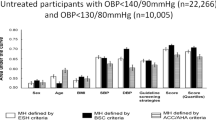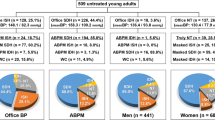Abstract
Isolated systolic hypertension (ISHT) is common in elderly patients, whilst its prevalence and clinical impact in young adults are still debated. We aimed to estimate prevalence and clinical characteristics of ISHT and to evaluate out-of-office BP levels and their correlations with office BP in young adults. A single-center, cross-sectional study was conducted at our Hypertension Unit, by including treated and untreated individuals aged 18–50 years, who consecutively underwent home, clinic and 24 h ambulatory BP assessment. All BP measurements were performed and BP thresholds were set according to European guidelines: normotension (NT), clinic BP <140/<90 mmHg; ISHT, BP ≥140/<90 mmHg; isolated diastolic hypertension (IDHT), BP <140/≥90 mmHg; systolic–diastolic hypertension (SDHT), BP ≥140/≥90 mmHg. European SCORE, vascular and cardiac HMOD were also assessed. From an overall sample of 13,053 records, we selected 2127 young outpatients (44.2% female, age 40.5 ± 7.4 years, BMI 26.7 ± 5.0 kg/m2, clinic BP 141.1 ± 16.1/94.1 ± 11.8 mmHg, 24 h BP 129.0 ± 12.8/82.4 ± 9.8 mmHg), among whom 587 (27.6%) had NT, 391 (18.4%) IDHT, 144 (6.8%) ISHT, and 1005 (47.2%) SDHT. Patients with ISHT were predominantly male (61.1%), younger and with higher BMI compared to other groups. They also showed higher home and 24 h ambulatory SBP levels than those with NT or IDHT (P < 0.001), though similar to those with SDHT. ISHT patients showed significantly higher pulse pressure (PP) levels than other groups, at all BP measurements (P < 0.001 for all comparisons), and significantly higher proportion (65.3%) of patients with ISHT had PP >60 mmHg. European SCORE resulted significantly higher in patients with ISHT (1.6 ± 2.9%) and SDHT (1.5 ± 2.7%) compared to those with IDHT (0.9 ± 1.5%) or NT (0.8 ± 1.9%) (P = 0.017). Though relatively rare, ISHT should be not viewed as a benign condition, being associated with sustained SBP elevation, high European SCORE risk, and vascular HMOD.
This is a preview of subscription content, access via your institution
Access options
Subscribe to this journal
Receive 12 digital issues and online access to articles
$119.00 per year
only $9.92 per issue
Buy this article
- Purchase on Springer Link
- Instant access to full article PDF
Prices may be subject to local taxes which are calculated during checkout


Similar content being viewed by others
References
Williams B, Mancia G, Spiering W, Agabiti Rosei E, Azizi M, Burnier M, et al. 2018 ESC/ESH Guidelines for the management of arterial hypertension. Eur Heart J. 2018;39:3021–104.
Franklin SS, Jacobs MJ, Wong ND, L’Italien GJ, Lapuerta P. Predominance of isolated systolic hypertension among middle-aged and elderly US hypertensives: analysis based on National Health and Nutrition Examination Survey (NHANES) III. Hypertension. 2001;37:869–74.
Wallace SM, Yasmin, McEniery CM, Mäki-Petäjä KM, Booth AD, Cockcroft JR, et al. Isolated systolic hypertension is characterized by increased aortic stiffness and endothelial dysfunction. Hypertension. 2007;50:228–33.
Saladini F, Palatini P. Isolated systolic hypertension in young individuals: pathophysiological mechanisms, prognostic significance, and clinical implications. High Blood Press Cardiovasc Prev. 2017;24:133–9.
Staessen JA, Fagard R, Thijs L, Celis H, Arabidze GG, Birkenhäger WH, et al. Randomised double-blind comparison of placebo and active treatment for older patients with isolated systolic hypertension. The Systolic Hypertension in Europe (Syst-Eur) Trial Investigators. Lancet. 1997;350:757–64.
Prevention of stroke by antihypertensive drug treatment in older persons with isolated systolic hypertension. Final results of the Systolic Hypertension in the Elderly Program (SHEP). SHEP Cooperative Research Group. JAMA. 1991;265:3255–64.
Curb JD, Pressel SL, Cutler JA, Savage PJ, Applegate WB, Black H, et al. Effect of diuretic-based antihypertensive treatment on cardiovascular disease risk in older diabetic patients with isolated systolic hypertension. Systolic Hypertension in the Elderly Program Cooperative Research Group. JAMA. 1996;276:1886–92.
Radchenko GD, Torbas OO, Sirenko YM. Predictors of high central blood pressure in young with isolated systolic hypertension. Vasc Health Risk Manag. 2016;12:321–8.
Palatini P, Saladini F, Mos L, Fania C, Mazzer A, Casiglia E. Clinical characteristics and risk of hypertension needing treatment in young patients with systolic hypertension identified with ambulatory monitoring. J Hypertens. 2018;36:1810–5.
Clement DL, De Buyzere ML, De Bacquer DA, de Leeuw PW, Duprez DA, Fagard RH, et al. Prognostic value of ambulatory blood-pressure recordings in patients with treated hypertension. N Engl J Med. 2003;348:2407–15.
Parati G, Omboni S, Palatini P, Rizzoni D, Bilo G, Valentini M, et al. Italian society of hypertension guidelines for conventional and automated blood pressure measurement in the office, at home and over 24 h. High Blood Press Cardiovasc Prev. 2008;15:283–310.
Parati G, Stergiou G, O’Brien E, Asmar R, Beilin L, Bilo G, et al. European Society of Hypertension practice guidelines for ambulatory blood pressure monitoring. J Hypertens. 2014;32:1359–66.
Palatini P, Rosei EA, Avolio A, Bilo G, Casiglia E, Ghiadoni L, et al. Isolated systolic hypertension in the young: a position paper endorsed by the European Society of Hypertension. J Hypertens. 2018;36:1222–36.
Figliuzzi I, Presta V, Miceli F, Citoni B, Coluccia R, Ceccarini G, et al. 24-Hour ambulatory blood pressure levels and control in a large cohort of adult outpatients with different classes of obesity. J Hum Hypertens. 2019;33:298–307.
Tocci G, Presta V, Figliuzzi I, Attalla El Halabieh N, Battistoni A, Coluccia R, et al. Prevalence and clinical outcomes of white-coat and masked hypertension: analysis of a large ambulatory blood pressure database. J Clin Hypertens. 2018;20:297–305.
Expert Panel on Detection, Evaluation, and Treatment of High Blood Cholesterol in Adults. Executive Summary of The Third Report of The National Cholesterol Education Program (NCEP) Expert Panel on Detection, Evaluation, And Treatment of High Blood Cholesterol In Adults (Adult Treatment Panel III). JAMA. 2001;285:2486–97.
Ryden L, Standl E, Bartnik M, Van den Berghe G, Betteridge J, de Boer MJ, et al. Guidelines on diabetes, pre-diabetes, and cardiovascular diseases: executive summary. The Task Force on Diabetes and Cardiovascular Diseases of the European Society of Cardiology (ESC) and of the European Association for the Study of Diabetes (EASD). Eur Heart J. 2007;28:88–136.
Conroy RM, Pyorala K, Fitzgerald AP, Sans S, Menotti A, De Backer G, et al. Estimation of ten-year risk of fatal cardiovascular disease in Europe: the SCORE project. Eur Heart J. 2003;24:987–1003.
O’Rourke MF, Vlachopoulos C, Graham RM. Spurious systolic hypertension in youth. Vasc Med. 2000;5:141–5.
Mahmud A, Feely J. Spurious systolic hypertension of youth: fit young men with elastic arteries. Am J Hypertens. 2003;16:229–32.
McEniery CM, Yasmin, Wallace S, Maki-Petaja K, McDonnell B, Sharman JE, et al. Increased stroke volume and aortic stiffness contribute to isolated systolic hypertension in young adults. Hypertension. 2005;46:221–6.
McEniery CM, Franklin SS, Cockcroft JR, Wilkinson IB. Isolated systolic hypertension in young people is not spurious and should be treated: pro side of the argument. Hypertension. 2016;68:269–75.
O’Rourke MF, Adji A. Guidelines on guidelines: focus on isolated systolic hypertension in youth. J Hypertens. 2013;31:649–54.
McEniery CM, Franklin SS, Wilkinson IB, Cockcroft JR. Isolated systolic hypertension in the young: a need for clarity. J Hypertens. 2013;31:1911–3.
Franklin SS, Wilkinson IB, McEniery CM. Unusual hypertensive phenotypes: what is their significance? Hypertension. 2012;59:173–8.
Protogerou AD, Blacher J, Safar ME. Isolated systolic hypertension: ‘to treat or not to treat’ and the role of central haemodynamics. J Hypertens. 2013;31:655–8.
Mancia G, Giannattasio C. Diagnostic and therapeutic problems of isolated systolic hypertension. J Hypertens. 2015;33:33–43.
Sundstrom J, Neovius M, Tynelius P, Rasmussen F. Association of blood pressure in late adolescence with subsequent mortality: cohort study of Swedish male conscripts. BMJ. 2011;342:d643.
Yano Y, Stamler J, Garside DB, Daviglus ML, Franklin SS, Carnethon MR, et al. Isolated systolic hypertension in young and middle-aged adults and 31-year risk for cardiovascular mortality: the Chicago Heart Association Detection Project in Industry study. J Am Coll Cardiol. 2015;65:327–35.
Omboni S, Aristizabal D, De la Sierra A, Dolan E, Head G, Kahan T, et al. Hypertension types defined by clinic and ambulatory blood pressure in 14 143 patients referred to hypertension clinics worldwide. Data from the ARTEMIS study. J Hypertens. 2016;34:2187–98.
Hänninen MR, Niiranen TJ, Puukka PJ, Kesäniemi YA, Kähönen M, Jula AM. Target organ damage and masked hypertension in the general population: the Finn-Home study. J Hypertens. 2013;31:1136–43.
Cuspidi C, Rescaldani M, Sala C, Negri F, Grassi G, Mancia G. Prevalence of electrocardiographic left ventricular hypertrophy in human hypertension: an updated review. J Hypertens. 2012;30:2066–73.
Cuspidi C, Paoletti F, Tadic M, Sala C, Dell’Oro R, Grassi G, et al. American versus European hypertension guidelines: the case of white coat hypertension. Am J Hypertens. 2020;33:629–33.
Mancia G. Clinical significance of white-coat hypertension. J Hypertens. 2016;34:623–6.
Author information
Authors and Affiliations
Corresponding author
Ethics declarations
Conflict of interest
The authors declare no competing interests.
Additional information
Publisher’s note Springer Nature remains neutral with regard to jurisdictional claims in published maps and institutional affiliations.
Rights and permissions
About this article
Cite this article
Citoni, B., Figliuzzi, I., Presta, V. et al. Prevalence and clinical characteristics of isolated systolic hypertension in young: analysis of 24 h ambulatory blood pressure monitoring database. J Hum Hypertens 36, 40–50 (2022). https://doi.org/10.1038/s41371-021-00493-9
Received:
Revised:
Accepted:
Published:
Issue Date:
DOI: https://doi.org/10.1038/s41371-021-00493-9



